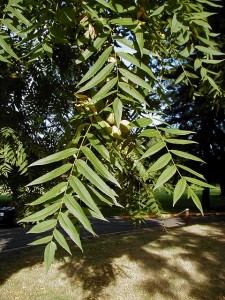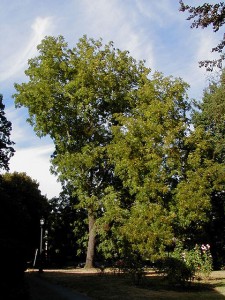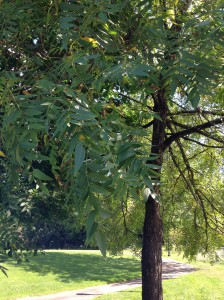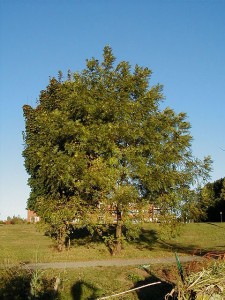Genus: Juglans
Family: Juglandaceae
Walnut trees are not always easy to live with. For one thing, some species are homes for aphids that produce a mess on cars, tables, or anything else below. Walnut pollen can also provoke an allergic reaction and the trees can harm a garden by producing a chemical that inhibits the growth of other plants. And, of course, there are the husks that stain hands, clothing, and sidewalks. But, if you can put up with all that, the trees do produce tasty, edible nuts.
Black Walnut
Scientific name: Juglans nigra
 Settlers planted these walnut trees from nuts brought along on the wagon trains from their native central and eastern portions of the U.S. An open, rounded, full tree, it can reach a height of 150 feet. The wood is used in carpentry projects and is highly prized for its beauty. The tree is coarse branched, with bold pungent, pinnately compound foliage that turns a clear light yellow in fall.
Settlers planted these walnut trees from nuts brought along on the wagon trains from their native central and eastern portions of the U.S. An open, rounded, full tree, it can reach a height of 150 feet. The wood is used in carpentry projects and is highly prized for its beauty. The tree is coarse branched, with bold pungent, pinnately compound foliage that turns a clear light yellow in fall.
View tree page and map.English Walnut
Scientific name: Juglans regia
 A deciduous tree thought to have originated near Persia, this tree is also known as the Persian Walnut. It bears small, female flowers that develop into the nuts and separate male flowers called "catkins" that produce the needed pollen. Leaves have 5 to 7 leaflets on one leaf stem. Tree is grown for its nuts and wood, and as an ornamental. There are many English Walnuts in the greater Portland area.
A deciduous tree thought to have originated near Persia, this tree is also known as the Persian Walnut. It bears small, female flowers that develop into the nuts and separate male flowers called "catkins" that produce the needed pollen. Leaves have 5 to 7 leaflets on one leaf stem. Tree is grown for its nuts and wood, and as an ornamental. There are many English Walnuts in the greater Portland area.
View tree page and map.